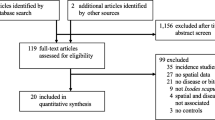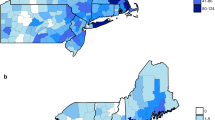Abstract
The purpose of this study was two-fold. First, we sought to identify spatial clusters of self-reported tick-borne disease (TBD) diagnosis in Indiana. Secondly, we determined the significant predictors of self-reported TBD diagnosis in a sample of Indiana residents. Study participants were selected from existing online panels maintained by Qualtrics and completed a cross-sectional survey (n = 3003). Our primary outcome of interest was self-reported TBD diagnosis (Yes/No). Cases and background population were aggregated to the county level. We used a purely spatial discrete Poisson model in SatScan® to determine significant clusters of high-risk TBD diagnosis counties. We also used X2 tests in bivariate analyses, to identify potential predictor variables for inclusion in an initial model, and backward elimination selection method to identify the final model. Two clusters of counties with significant high relative risk of self-reported TBD diagnosis in the southeast and southwest of Indiana were detected. Males in Indiana were more likely to self-report TBD diagnosis compared to females. Study participants who conducted a thorough tick check after being outdoors were significantly less likely to report TBD diagnosis compared to those who did not. Increased positive perceptions of TBD personal protective measures were associated with reduced self-reported TBD diagnosis. Older study participants were less likely to self-report TBD diagnosis compared to younger participants. The identification of two clusters of TBD diagnosis in southern Indiana is consistent with a northern spread of TBDs and suggests a need for continued surveillance of the counties in the vicinity of the observed clusters. Future studies should be designed to identify risk factors for TBD diagnosis in the affected counties of Indiana.

Similar content being viewed by others
References
U.S. Centers for Disease Control and Prevention [CDC]. Behavioral risk factor surveillance system 2014. Retrieved May 25, 2019, from https://www.cdc.gov/brfss/about/index.htm.
Social Research Center. New South Wales Population health survey 2019. Retrieved May 25, 2019, from https://www.srcentre.com.au/our-research/new-south-wales-population-health-survey.
Department of Health and Human Services. Tick-Borne Disease Working Group-2018 report to Congress 2019. Retrieved March 20, 2019, from https://www.hhs.gov/sites/default/files/tbdwg-report-to-congress-2018.pdf.
Caminade, C., McIntyre, K. M., & Jones, A. E. (2018). Impact of recent and future climate change on vector-borne diseases. Annals of the New York Academy of Sciences., 1436, 157–173.
Raghavan, R. K., Peterson, A. T., Cobos, M. E., Ganta, R., & Foley, D. (2019). Current and future distribution of the Lone Star Tick, Amblyomma americanum (L.)(Acari: Ixodidae) in North America. PloS ONE, 14(1), e0209082.
Kugeler, K. J., Farley, G. M., Forrester, J. D., & Mead, P. S. (2015). Geographic distribution and expansion of human Lyme Disease, United States. Emerging Infectious Diseases, 21(8), 1455–1457.
Adjemian, J. Z., Krebs, J., Mandel, E., & McQuiston, J. (2009). Spatial clustering by disease severity among reported Rocky Mountain spotted fever cases in the United States, 2001–2005. The American Journal of Tropical Medicine and Hygiene, 80(1), 72–77.
Jones, E., Hinckley, A., Hook, S., Meek, J., Backenson, B., Kugeler, K., et al. (2018). Pet ownership increases human risk of encountering ticks. Zoonoses and Public Health, 65(1), 74–79.
Richardson, M., Khouja, C., & Sutcliffe, K. (2018). Interventions to prevent Lyme disease in humans: A systematic review. Preventive Medicine Reports., 13, 16–22.
Connally, N. P., Durante, A. J., Yousey-Hindes, K. M., Meek, J. I., Nelson, R. S., & Heimer, R. (2009). Peridomestic Lyme disease prevention: Results of a population-based case–control study. American Journal of Preventive Medicine, 37(3), 201–206.
Omodior, O., Pennington-Gray, L., & Donohoe, H. (2015). Efficacy of the theory of planned behavior in predicting the intention to engage in tick-borne disease personal protective behavior amongst visitors to an outdoor recreation center. Journal of Park and Recreation Administration., 33(2), 37–53.
Donohoe, H., Omodior, O., & Roe, J. (2018). Tick-borne disease occupational risks and behaviors of Florida Fish, Wildlife, and Parks Service employees: A health belief model perspective. Journal of Outdoor Recreation and Tourism, 22, 9–17.
Stefanoff, P., Rosinska, M., Samuels, S., White, D. J., Morse, D. L., & Randolph, S. E. (2012). A national case-control study identifies human socio-economic status and activities as risk factors for tick-borne encephalitis in Poland. PLoS ONE, 7(9), e45511.
Slunge, D., & Boman, A. (2018). Learning to live with ticks? The role of exposure and risk perceptions in protective behaviour against tick-borne diseases. PLoS ONE, 13(6), e0198286.
Aenishaenslin, C., Michel, P., Ravel, A., Gern, L., Milord, F., Waaub, J.-P., et al. (2015). Factors associated with preventive behaviors regarding Lyme disease in Canada and Switzerland: A comparative study. BMC Public Health, 15(1), 185.
Herrington, J. E., Jr. (2004). Risk perceptions regarding ticks and Lyme disease: A national survey. American Journal of Preventive Medicine, 26(2), 135–140.
Mowbray, F., Amlôt, R., & Rubin, G. J. (2014). Predictors of protective behaviour against ticks in the UK: A mixed methods study. Ticks and Tick-Borne Diseases, 5(4), 392–400.
Beaujean, D. J. M. A., Bults, M., van Steenbergen, J. E., & Voeten, H. A. C. M. (2013). Study on public perceptions and protective behaviors regarding Lyme disease among the general public in the Netherlands: Implications for prevention programs. BMC Public Health, 13(1), 225.
Arıkan, I., Kasifoglu, N., Metintas, S., & Kalyoncu, C. (2010). Knowledge, beliefs, and practices regarding tick bites in the Turkish population in a rural area of the Middle Anatolian Region. Tropical Animal Health and Production, 42(4), 669–675.
Centers for Disease Control and Prevention. Lyme Disease Charts and Figures: Most Recent Year 2018. Retrieved May 20, 2019, from https://www.cdc.gov/lyme/datasurveillance/charts-figures-recent.html.
Bayles, B. R., Evans, G., & Allan, B. F. (2013). Knowledge and prevention of tick-borne diseases vary across an urban-to-rural human land-use gradient. Ticks and Tick-Borne Diseases, 4(4), 352–358.
Aenishaenslin, C., Bouchard, C., Koffi, J. K., & Ogden, N. H. (2017). Exposure and preventive behaviours toward ticks and Lyme disease in Canada: Results from a first national survey. Ticks and Tick-Borne Diseases, 8(1), 112–118.
Qualtrics. Qualtrics 2018. Retrieved December 21, 2018, from https://uits.iu.edu/qualtrics.
Kulldorff, M., Heffernan, R., Hartman, J., Assunçao, R., & Mostashari, F. (2005). A space–time permutation scan statistic for disease outbreak detection. PLoS Medicine, 2(3), e59.
Kulldorff, M. (2017). SaTScan user guide for version 9.4. 2015.
Tjur, T. (2009). Coefficients of determination in logistic regression models—A new proposal: The coefficient of discrimination. The American Statistician, 63(4), 366–372.
U.S. Department of Agriculture [USDA]. Indiana: Three rural classifications based on Census places n.d. Retrieved April 22, 2019, from https://www.ers.usda.gov/webdocs/DataFiles/53180/25569_IN.pdf?v=0.
LoGiudice, K., Ostfeld, R. S., Schmidt, K. A., & Keesing, F. (2003). The ecology of infectious disease: Effects of host diversity and community composition on Lyme disease risk. Proceedings of the National Academy of Sciences, 100(2), 567–571.
Salkeld, D. J., & Lane, R. S. (2010). Community ecology and disease risk: Lizards, squirrels, and the Lyme disease spirochete in California, USA. Ecology, 91(1), 293–298.
Daltroy, L. H., Phillips, C., Lew, R., Wright, E., Shadick, N. A., Liang, M. H., et al. (2007). A controlled trial of a novel primary prevention program for Lyme disease and other tick-borne illnesses. Health Education & Behavior, 34(3), 531–542.
Butler, A. D., Sedghi, T., Petrini, J. R., & Ahmadi, R. (2016). Tick-borne disease preventive practices and perceptions in an endemic area. Ticks and Tick-Borne Diseases, 7(2), 331–337.
Wallace, L. A. (1991). Comparison of risks from outdoor and indoor exposure to toxic chemicals. Environmental Health Perspectives, 95, 7–13.
U.S. Centers for Disease Control and Prevention [CDC]. Anaplasmosis-epidemiology and statistics 2019. Retrieved May 27, 2019, from https://www.cdc.gov/anaplasmosis/stats/index.html.
Flynn, J., Slovic, P., & Mertz, C. K. (1994). Gender, race, and perception of environmental health risks. Risk Analysis, 14(6), 1101–1108.
Slovic, P., & Peters, E. (2006). Risk perception and affect. Current Directions in Psychological Science, 15(6), 322–325.
Sheeran, P., Harris, P. R., & Epton, T. (2014). Does heightening risk appraisals change people’s intentions and behavior? A meta-analysis of experimental studies. Psychological Bulletin, 140(2), 511.
Acknowledgements
This project was supported by the Environmental Resilience Institute (ERI), funded by Indiana University’s Prepared for Environmental Change (PfEC) Grand Challenge initiative.
Author information
Authors and Affiliations
Corresponding author
Ethics declarations
Conflict of interest
The authors have no conflict of interest to declare.
Additional information
Publisher's Note
Springer Nature remains neutral with regard to jurisdictional claims in published maps and institutional affiliations.
Electronic supplementary material
Below is the link to the electronic supplementary material.
Rights and permissions
About this article
Cite this article
Omodior, O., Kianersi, S. & Luetke, M. Spatial Clusters and Non-spatial Predictors of Tick-Borne Disease Diagnosis in Indiana. J Community Health 44, 1111–1119 (2019). https://doi.org/10.1007/s10900-019-00691-0
Published:
Issue Date:
DOI: https://doi.org/10.1007/s10900-019-00691-0




